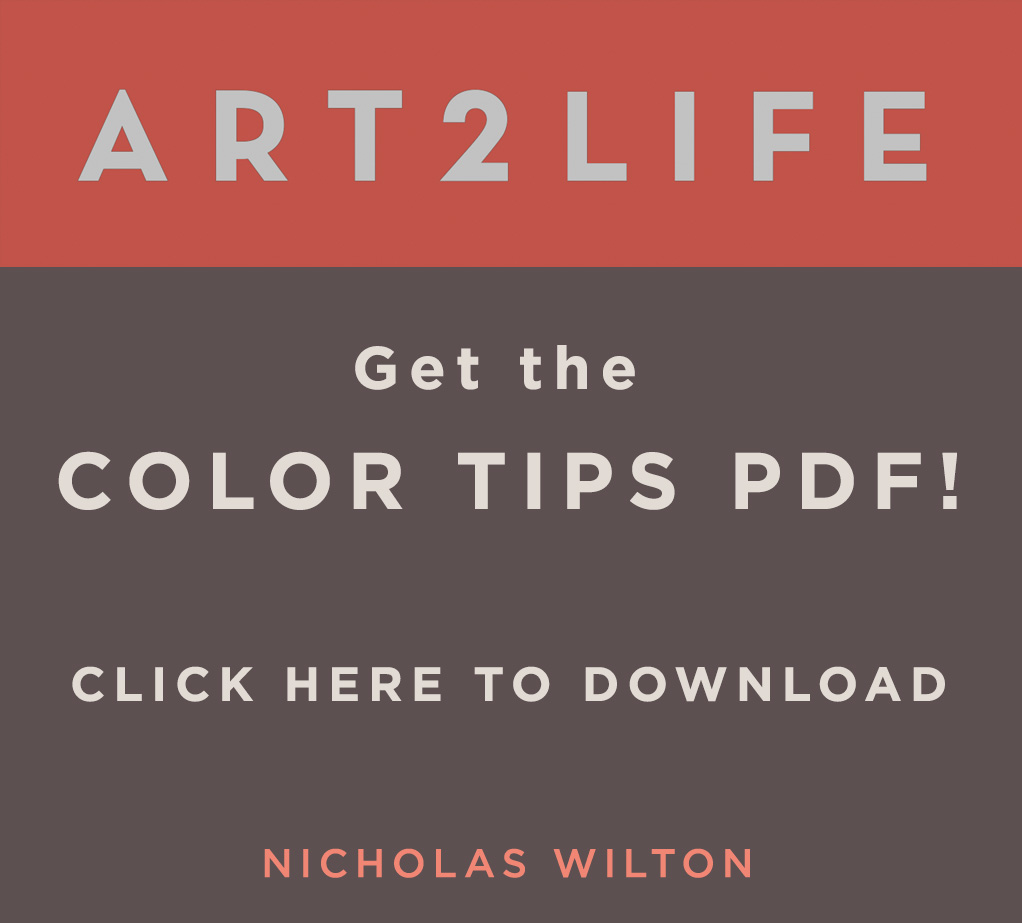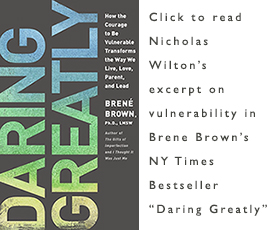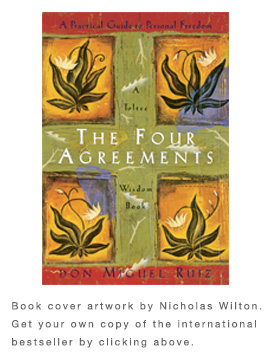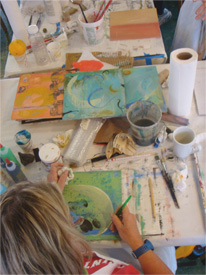How Your Art Practice can Help You Live Fully
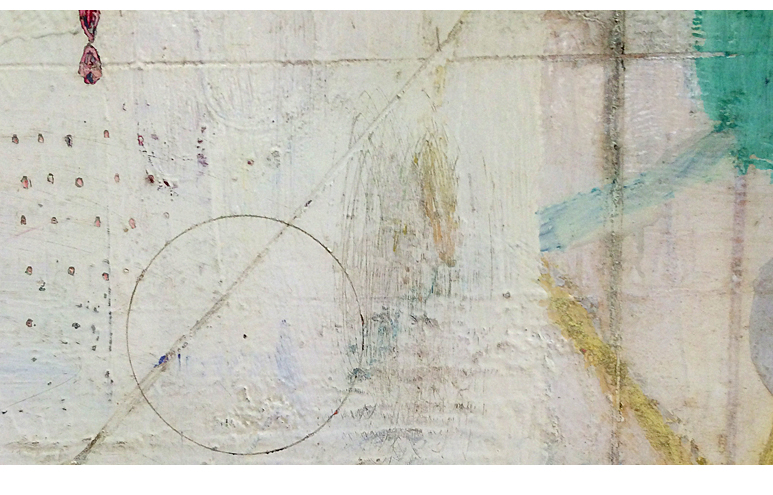 Pema Chodrun speaks and teaches extensively on Buddhism and becoming more conscious in our lives. She teaches that in order to live fully we should try to “experience each moment as completely new and fresh.” This teaching resonates with me. I see this idea, however, as more easily accomplished in my art practice than in my regular busy life. There is more focus, more consciousness when I set the time aside to make my Art. Certainly more than driving around in traffic, doing errands, all the while talking on my iPhone. Compared to that, my art practice seems almost monastic. But surely that is a good thing. I know from experience that over time, my Art Practice positively changes my Life.
Pema Chodrun speaks and teaches extensively on Buddhism and becoming more conscious in our lives. She teaches that in order to live fully we should try to “experience each moment as completely new and fresh.” This teaching resonates with me. I see this idea, however, as more easily accomplished in my art practice than in my regular busy life. There is more focus, more consciousness when I set the time aside to make my Art. Certainly more than driving around in traffic, doing errands, all the while talking on my iPhone. Compared to that, my art practice seems almost monastic. But surely that is a good thing. I know from experience that over time, my Art Practice positively changes my Life.
I also know that I simply cannot generate any worthwhile Art unless I am fully present. I cannot multi task and make art at the same time. I can’t even listen to the radio.
Once in the studio and beginning to paint, my goal is to transition as quickly as possible to this state of experiencing each moment of creativity as “completely new and fresh.”
This can be difficult. However, I have developed several ways that help me become present and engaged when making my art. Maybe these can help you too….
Wait as long as possible to decide which end is up.
Simply flip your Art as you work on it. Turn it sideways, upside down and just keep working. I find this so fun and it stops me from seeing it too long in the same way. You simply cannot become attached if the work is changing so dramatically. The longer I wait before deciding what is the final orientation the more substantial the final work often will be.
Make Marks in response to how you are feeling, not what you are seeing.
I know this sounds crazy but if we base some of our decisions upon how we are actually feeling instead of what we are seeing, especially in the beginning, the work will change and evolve quite differently and more unexpectedly. Surprise, chance and spontaneity awaken us. Habitual thinking and excessively figuring out what we should do next leads to self consciousness which eventually leads to boredom – not just for you, but the viewer as well. Try to stay really engaged with how the area you are working on is making you feel, not necessarily how it looks.
Judge your work by how you feel making it.
Judge the work in the beginning by how you are feeling. Are you engaged, are you awake? Is this joyful, engaging? Have you lost track of time? Do you ever dance while you are working? In short, your art practice is where you literally practice being alive. I find it a good rehearsal for how I want to try and be in the rest of my life. The soul knows when you are feeling alive and will let you know by delivering you powerful, authentic artwork.
I believe one of the primary reasons we make Art is how it makes us feel when we are in the process of actually making it. The gift for the artist, in the end, isn’t the finished artwork.
Maybe the gift is given while we are making the art, when for just a moment or two we feel a little more awake, a little more alive than we ever have before.
So, how do you feel when you make your Art?
In gratitude, Nicholas
Two Ways to Make a Color Extraordinary
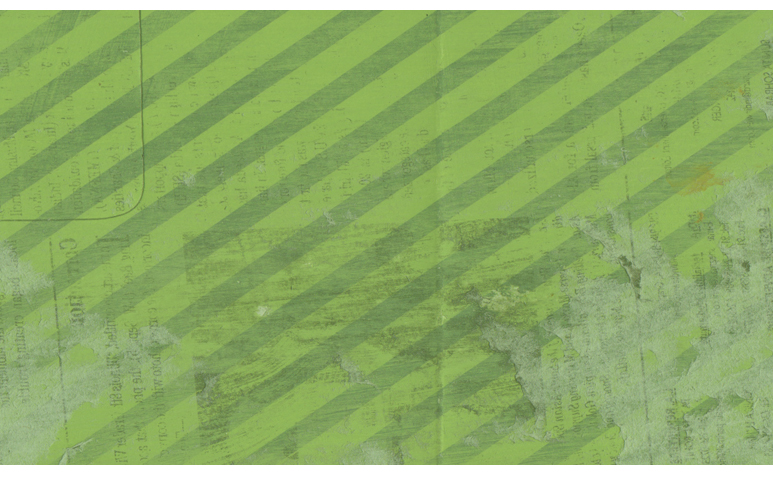 Recently I found the most beautiful green I have ever seen. I didn’t find it by mixing paint, nor did I find it in another artist’s work. I found it, quite by accident, at a cooking class in a pot of simmering pea soup. I had never made pea soup by shelling all the peas out of the pod, nor had I used watercress before in anything except maybe an occasional salad. For this soup we used both, along with mint leaves, also an amazing green color, shallots and fresh thyme.
Recently I found the most beautiful green I have ever seen. I didn’t find it by mixing paint, nor did I find it in another artist’s work. I found it, quite by accident, at a cooking class in a pot of simmering pea soup. I had never made pea soup by shelling all the peas out of the pod, nor had I used watercress before in anything except maybe an occasional salad. For this soup we used both, along with mint leaves, also an amazing green color, shallots and fresh thyme.
I loved the taste, as did everyone in the class, but the bright green color of this soup was simply extraordinary. As the circle of green in my bowl grew smaller I couldn’t help wondering why this color was so fantastic. Why does color sometimes just take your breath away? Certainly there are zillions of greens we see every day. Why does this green of my soup stand out? I should know the answer as I am in the business of making colors, but it took me a while to figure it out.
It threw me for a few minutes because, after all, this is not a painting – this is pea soup. But really it doesn’t matter what it is…principles of color should apply. And they do. By the time we were eating the desert portion of the class (Mayan mystery cookies, also good) I realized why.
There are two primary principles of color at play here.
#1 Color Richness is Created with Many Colors
Mostly it is because it is a green made up of many tiny particles of green, in this case the peas, the mint leaves, the watercress and the darker thyme leaves. There probably is a gazillion particles in my single bowl of soup. In other words, these micro contrasts of different greens create the overall richness of green. The primary difference between a square inch of the surface of my soup and, say, a gallon of green paint from Home Depot, is that my green was created from millions of fragments, particles, of slightly different greens. They optically mix and from an arms length away, the color melds together as one even green color. This kind of color, one made from many colors, is just richer, plain and simple, than one uniform painted area of flat color.
The reminder, again for me, and I hope maybe for you too, is that an area of color is often made more scrumptious if we can spend the time and attention to create it from not just one, but many colors, alongside one another. It is not just your eyes, but also everyone else’s, that can see the difference.
#2 Color Richness is Created with Depth
The second reason that the green of my soup is so beautiful is because of a second contrast: depth of color. One of the most enriching aspects of color happens when a single color’s surface is comprised of smaller areas that appear to come forward and also recede towards the background. My soup has particles of green that are doing this. Some are right on the surface (foreground) and then right beside those are other similar particles that are partially submerged. (background). The ones below the surface are slightly out of focus, slightly dimmer and distant when compared to the bright green bits of pea and mint that sit right up close on the surface. Experiencing a color that is made up of tiny color specks coming forward, contrasted with some that are receding (the ones pushed below the surface) creates extraordinary richness of color.
This happens in art making by using glazes, when thin washes of related color partially cover more opaque color. Having a surface that alternates between glazed (green pea particles under the surface) and opaque (green pea particles upon the surface) provides a visual contrast that enhances our sensory experience of the color and gives it richness.
Sometimes color looks good enough to eat. In this case you can.
To see the recipe for the Amazing Green Pea Soup, click here. And of I course I have to give credit to the San Francisco Cooking School for the recipe – to learn more about them click here.
Note: It helps if you use homemade chicken stock and fresh organic watercress and peapods.
What colors from life capture your eye?
Bon Appetit,
Nicholas
The Idea that Will Improve Your Art Practice
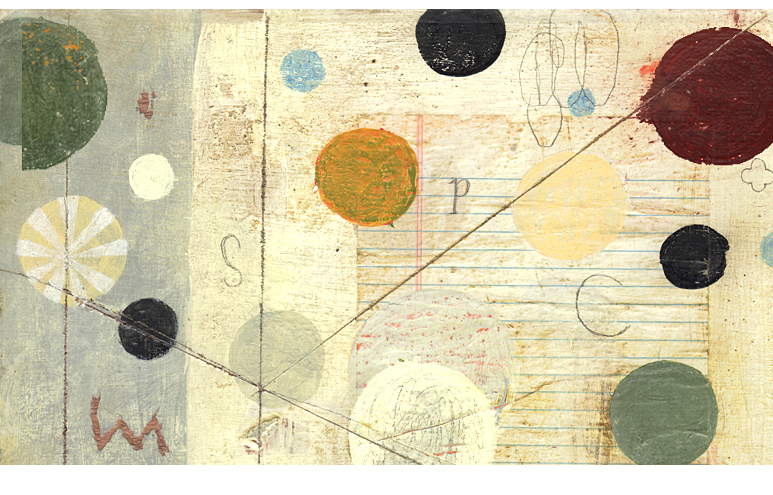 People ask me where the ideas come from that I write about and I tell them they come mostly from my Art Practice. These thoughts arrive while I am standing in front of my paintings. But they also just come from my life. This makes sense because, as most of you already know, your Art and Life often ride tandem.
People ask me where the ideas come from that I write about and I tell them they come mostly from my Art Practice. These thoughts arrive while I am standing in front of my paintings. But they also just come from my life. This makes sense because, as most of you already know, your Art and Life often ride tandem.
In many ways stopping to write drops you directly into the present. This also happens for me when I work on my paintings. Each day is different. And yet somehow they are connected.
I am understanding more and more that this connection of disparate attempts on random different days in the studio is made clearer by actually seeing the accumulation of past art. I think we are most satisfied when we feel we are progressing, when we improve. I look at older paintings and think to myself how could I have gone on with such weak work and not have gotten totally discouraged?
But it is all about the progression. I just thank my lucky stars that I am here now and not back there with all that confusion and garish over worked art. Of course I realize this “now” is no different than the “now” back then. I just don’t know that my work today will be that same weaker work of yesterday which will fall dramatically out of my favor in the future. This is a good thing of course, because if I did know what I will know in the future then I would probably hate what I am doing now and most likely would stop.
I never know what I will feel before I drop into my art practice or even what will come up as I start sifting through my thoughts for this weekly blog. I just know that there will be something, some kind of reaction or over riding sentiment that colors my creative experience. And every day it will be different. It always is. I like to think things are getting more refined, but on that point I am not entirely sure.
I am always comforted, however, by the fact that I can see my results. At the end of the day a piece of Art exists. The wonderful thing about making things, whether they are paintings, photographs, sculptures or whatever, is there ends up being a visual record of your time. Your resulting art becomes a placeholder for the progression of time that you have experienced.
As the time is spent and more and more of whatever you make piles up behind you, all that is left to do is ask oneself “Well, am I improving?”
The answer is almost always affirmative. It seems difficult to do anything with even sporadic regularity and find on some level that you are not improving. This, it seems to me, is what keeps most of us coming back for more. It just is so darn amazing that a kind of maturity, a deeper sense of knowing almost naturally develops though repeated attempts. If we show up repeatedly, over time, we improve. And because this is so gratifying it engenders more creativity. Making more allows us to make more.
Understanding this fact is like finding a perfect, unbroken seashell upon a beach. It might even make us stop, just for a minute and really look into our hands at what we have just found. And then, before we begin again, ever so carefully slip it into our pocket so that in the not too distant future, when uncertainty undoubtedly returns, we will remember.
What has your experience been with looking at your past work?
In gratitude, Nicholas
My Favorite Secret Habit of Highly Effective People
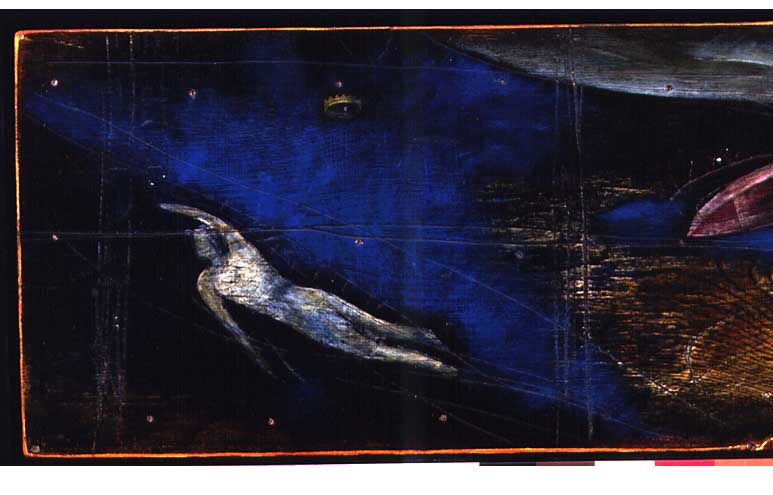 I am right smack dab in the middle of a big pile of paintings for a new show in June. I have been working hard for several months. Fifty percent of my time has already been used up. Many paintings are started, but none are finished. How this body of work is going to turn out is not entirely clear yet, but being only halfway is never clear. It is a lot like swimming alone between two islands. At some point you will be equally far away from both. You are in the middle. And that sometimes can be a little scary.
I am right smack dab in the middle of a big pile of paintings for a new show in June. I have been working hard for several months. Fifty percent of my time has already been used up. Many paintings are started, but none are finished. How this body of work is going to turn out is not entirely clear yet, but being only halfway is never clear. It is a lot like swimming alone between two islands. At some point you will be equally far away from both. You are in the middle. And that sometimes can be a little scary.
That is where I am right now. In the middle. Usually I am quite stressed out at this point. I mean really stressed out. But not this time.
Interestingly, I think it has to do with something I have learned in the past couple of years. It came from a powerful book I read titled “The 7 Habits of Highly Effective People,” by Steve Covey. Covey presents an approach, almost a personal management system, to become more effective in attaining your goals. He offers up principles of character ethics that are universal and timeless along with 7 habits that together can greatly enhance your productivity and personal well-being.
The second of these habits, #2 “Begin with the End in Mind”, I have found most helpful in my life – especially, believe it or not, in my creative process.
Not so long ago I used to spend a great deal of time planning what my finished paintings were going to look like. I always did this when I had a big show of, say, 20 paintings that I had to create in several months. I never felt entirely confident that I would end up with a cohesive body of work if I didn’t almost half create the work ahead of time so I could at least imagine the finished paintings. How else would I know when to stop or where to specifically go if I didn’t have a plan? To not do otherwise was too scary. What if I came up with a bunch of weak work?
This habit – #2 “Begin with the End in Mind” – supports this idea of planning. Basically having an end result imagined does improve your decisions, especially when there is a singular goal in mind. This seems to work in almost any arena. Mission statements for businesses and institutions are an example of “keeping the end in mind”. We have all wanted something so badly that the end result stays centermost in our minds till this goal is realized.
In art making, however, I have found that overly planning and actually knowing too much about where I was going with my art killed some of the joy I had for making it in the first place.
So while I agree and have found that the habit of “Beginning with the End In Mind” helpful in almost all areas of my life, it didn’t help so much in the arena of my art making.
That is until I tweaked it. I simply changed the language. Now I “Begin with the ending ‘feeling’ in Mind”. In other words I try to imagine the emotional experience of those who will see the work, including myself, when I walk into the gallery. How do I want to feel? How do I want others to feel? For example, with my recent body of work, I want it to feel more intuitive and fresh. I want the viewer to experience firsthand my willingness to let the materials be themselves. I personally want to let my work become more filled with wonder and curiosity and risk than anything I have ever made previously. I want to show more of myself, I want people to feel who I am and what I care about more than ever before.
Notice that there is no visual indication or idea of what this will look like, only the feeling. This simple twist of words has given me tremendous freedom. I know much more quickly when to say “No” and it seems now I am saying “No” more frequently. There is much greater discernment this time around and I am quite certain this is a good thing.
Maya Angelou, the African American poet, actress and activist once said, “I’ve learned that people will forget what you said, people will forget what you did, but people will never forget how you made them feel.”
I believe this to be true. Especially in Art.
What helps you achieve your creative goals?
In gratitude, Nicholas
Three Ideas that can Inspire Your Art Practice
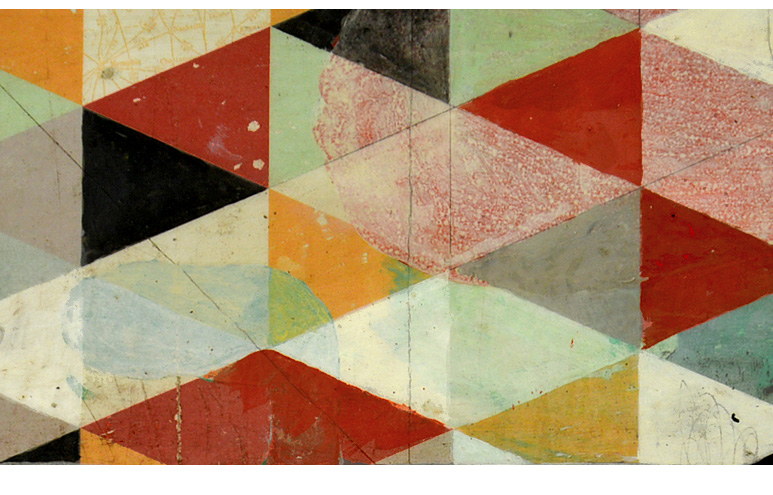 Pema Chodrun eloquently spoke of three primary teachings found in Tibetan Buddhism. Even though I am only mildly familiar with the basic tenants of Buddhism, oddly, the primary points she was making I innately understood already. I was familiar – not because I have studied or practiced Buddhism – but because I have spent most of my life making Art. Again, a similar curriculum.
Pema Chodrun eloquently spoke of three primary teachings found in Tibetan Buddhism. Even though I am only mildly familiar with the basic tenants of Buddhism, oddly, the primary points she was making I innately understood already. I was familiar – not because I have studied or practiced Buddhism – but because I have spent most of my life making Art. Again, a similar curriculum.
I thought the ideas she presented were so potent, so applicable to not just life but especially to the practice of making Art that I thought I would share them here.
There are three, but the first one is a doozer:
“We Already Have Everything We Need”
In ArtLife Workshops I am always trying to communicate this crucial idea to those who are tentatively sitting upon the sidelines instead of beginning their own art practice. In many instances in life, in the business world especially, there is great currency put on having credentials, advanced degrees and most importantly prior experience. This is true for almost anything new we would like to pursue.
Unfortunately, the need to have expertise, to have extensive training before we can participate often discourages our curiosity. This, however, is not the case for Art. Anyone who has the desire and the curiosity to embark upon making Art can. The only qualification for making Art is life experience. And all of us, without exception, are amply filled with this already.
“Start Where You Are”
Right here, right now is a good place to start. A meditation practice is not about later; an art practice is not either. The sublime beauty of both is quietly waiting right now. In the present. Once begun, both can teach us, remind us, to pay more attention to what is happening at this very moment.
Almost without exception, when I go into my studio to begin making Art, I do not know or feel particularly confident about what I will do. I used to put off organizing my life around a regular practice of art making, thinking that I did not know enough information, or that one day in the future I would be more prepared. And then I realized that day most likely would never come. So I just began where I was, with the little bit of information I had gleaned along the way. And I just began. I realize now, years later, that the most important decision of all that I was struggling with was that I decided to start.
“Move Toward Difficulty”
We are taught from an early age to avoid difficulty. This makes sense of course, but in time we realize this is not possible. Difficulty seems to come anyway. I used to strive for a seamless, beginning middle and happy ending in all I did, especially my Art. However, this too is impossible. And thankfully so.
My Art practice has showed me the folly of trying to avoid something in a painting that I am unsure about. In trying to avoid it, by painting around something to not interact with it, I only seem to make it more noticeable. Have you ever noticed this? It drives me crazy. The very thing I don’t want to deal with ends up sticking out like a sore thumb the more I ignore it. Peculiarly, it is the difficult thing that needs to be directly worked upon. This is, at least in my experience of making art, exactly where the lessons, the transformation – not just for your Art, but more importantly for your thinking – are waiting. The answers are held in the difficulty. This is a lesson I relearn again and again, not just in my Art but in my Life as well.
Sometimes I wonder if the reason we are driven to make Art is just to learn who we are or who we are becoming. It is, thankfully, not easily answered. It takes time. In fact, it takes a lifetime.
What ideas or concepts inform your art practice?
In gratitude, Nicholas
How to Make Art with Time on Your Side
 When I think about time I occasionally get a sinking feeling. Time is always passing. There is never enough. Once it is gone it is gone. The passing of every second, hour and day feels like a permanently declining savings account. A deposit simply cannot be made to correct this situation. These negative ideas about time have not been particularly helpful in any aspect of my life, especially the creative ones.
When I think about time I occasionally get a sinking feeling. Time is always passing. There is never enough. Once it is gone it is gone. The passing of every second, hour and day feels like a permanently declining savings account. A deposit simply cannot be made to correct this situation. These negative ideas about time have not been particularly helpful in any aspect of my life, especially the creative ones.
Here then, are several ways I now use time instead of the other way around. It turns out, like most everything else in life, the answer resides in your thinking.
Awareness trumps Time.
Sunday for me just seems to have more time in it, although I am quite sure it consists of 24 hours just like all the other days. Somewhere along the line I decided that on this day I would go slower. I love Sundays. My run is always long and slow. Conversational pace. I actually see more. I notice the cows. I pay attention to the leaf pattern beneath my feet. I simply breathe in more. Making breakfast takes longer as does eating it. I actually will read or at least look at the New York Times on this day. Everything feels slower and it feels fantastic.
The point being that when we consciously decide (and that is the operative word here) to pay attention to how things feel, taste, smell, sound and look, time seems to take a backseat. It slows down.
Making Art is a perfect example. Being present, being as aware as possible generates our best work. A day that has more moments of awareness within it just simply feels more fulfilling.
Using the Scarcity of Time to Motivate
This sounds counter intuitive to art making, but I use a stopwatch when I make art.
I use the slight fear I have of time constantly slipping away to improve not just my efficiency but also the boldness of my daily artistic effort.
What has helped me focus is the prior decision that I am going to work uninterrupted for 3 hours non-stop. Once I hit my stopwatch I just go for it. I occasionally look at my watch to see how I am doing…if the work seems stalled in front of me and I see I have been doing little for 23 minutes I push myself to take bolder moves. I want to change my work. I want it to happen and now is the time. The stopwatch is reminding me of this fact. As the end approaches, with only minutes remaining, I can push harder as the finish line is in sight. What can I do in the remaining minutes that will really make my day? What can I do right now that matters? Try this sometimes, it really works.
Having both less and more time is good.
Richness is created in our Art by the expression of differences. This is also true, of course, in our lives. We feel alive when we pass in and out of experiences that are different from one another. It feels good to work hard for 3 hours and then sit back for a slow lunch with a friend…much better than an unfocused 3 hour art making session that runs over into a hurried lunch eaten while trying to resolve what was not previously accomplished.
Choosing consciously when to go into brief periods of time awareness juxtaposed with allowing ourselves to slow down and amble more slowly is not only more efficient but just simply feels better. Time is like a river. Its rapids are where dramatic change occurs. It is intense and loud. Danger and Risk are everywhere. The water is shallow and moving very, very quickly. This kind of environment is where big changes can occur. When the river widens and the water slows down it becomes darker and deeper. It is quiet. This section of stillness and calm is when creative rejuvenation occurs. It is when ideas, plans and inspiration trickle in. It is in the slow moving time when there is finally spaciousness for new ideas. These two conditions, rapidity and calmness are complimentary. Both are needed. Experiencing them alternatively and allowing and deciding whole-heartedly to be in each one fully fosters creativity, change, and inspiration and as a result…. happiness.
Does the way you think about time help or hinder you? Please share you thoughts and comments below.
In gratitude, Nicholas
IMPROVING YOUR ART BY MISTAKE
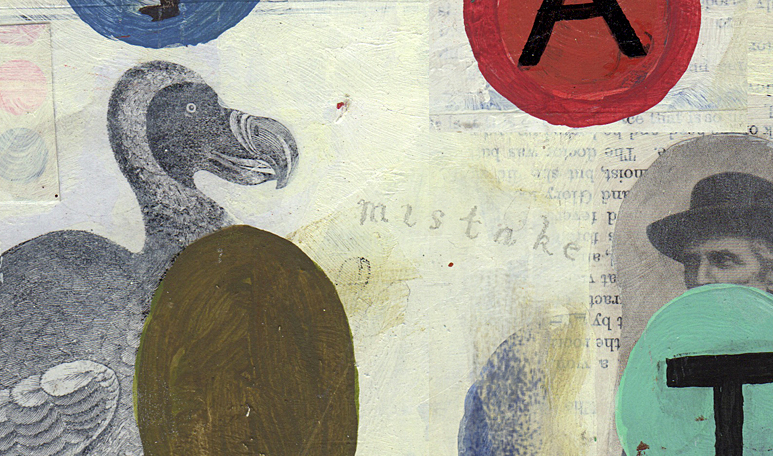 Sometimes life just seems like a long stream of corrected mistakes. I am not sure why we get so frustrated after the umpteenth time we have made an error. You would think we would learn and accept the fact that the mistake is simply inevitable.
Sometimes life just seems like a long stream of corrected mistakes. I am not sure why we get so frustrated after the umpteenth time we have made an error. You would think we would learn and accept the fact that the mistake is simply inevitable.
Making Art has helped me understand, accept and actually embrace my fallibility. On the first day of the ArtLife workshops I used to emphasize that it is perfectly ok to make mistakes. Everybody does. Lately, however, I have become clearer not only about the inevitability of missteps but the necessity of them. I now propose that making mistakes are actually essential, a vital component of strong Art; it just simply can’t happen without them. There always seems to be a collective sigh of relief in the room once I remind everyone of this fact. Of course we all know this to be true but maybe don’t always remember why.
I believe there are basically 3 Reasons why mistakes improve your Art.
Mistakes provide Authority.
Making Art is a practice, a lifetime journey from the moment you begin making art till the very day you stop. The success, the discoveries found along the way, is demonstrated by the progression of your artwork. There are millions of decisions that go into every single piece of art you make. The more decisions made in making your Art, I believe, the better you become at your Art. Your decisions are either correct or incorrect. If they feel right, they remain, but if not, then another decision is made in its place. And this one, this second decision, because it is derived in response to a prior incorrect one often expresses more refinement and more authority. These 2 part decisions are the ones that matter most. They can dramatically embolden your work. In Art, being wrong can pay off big time.
Mistakes make Correct more Correct.
Much of the power of Art is derived from the visual, auditory or conceptual differences presented. The viewer is made to feel something, or to see more clearly an idea that the artist has made more apparent. This is often achieved by the juxtaposition of opposites. An example of this would be a large shape next to a tiny one or a saturated color in close proximity to an unsaturated one. Allowing the evidence, the subtle remnants of a correction – an erased pencil mark for example – provides a perfect complementary setting for a correct, decisive one. The correctness, the confidence of the final mark is made even more so by the prior mistake. As a result the work overall is enhanced.
Mistakes allow others to access you.
Your Art, once completed, stands as an open invitation to anyone who is interested. There is a humility, an honesty that emanates from work that achieves success through struggle. When we feel the artist’s humanity, her decision making, it becomes an access point for the viewer. The bridge between artist and viewer becomes closer. There is almost a universal appeal for persistence, for the dogged pursuit of desire. The struggle inherent in work, the history of right and wrong turns, gives it maturity, and a level of depth and intrigue. This quality broadens the authenticity and therefore the accessibility of your art.
In the end, it is comforting to know that at least in the area of art making, nature is on our side. We seem hard-wired to make mistakes again and again. Thankfully, we can learn to become more sensitive and more refined in how we correct, how gracefully we can right our boat, and then, in front of all who are watching, set our sails and begin again.
What has your experience been with mistakes? Do you think we learn from them, or is the relationship something else?
In gratitude, Nicholas
HOW THE OTHER HALF THINKS ABOUT YOUR ART
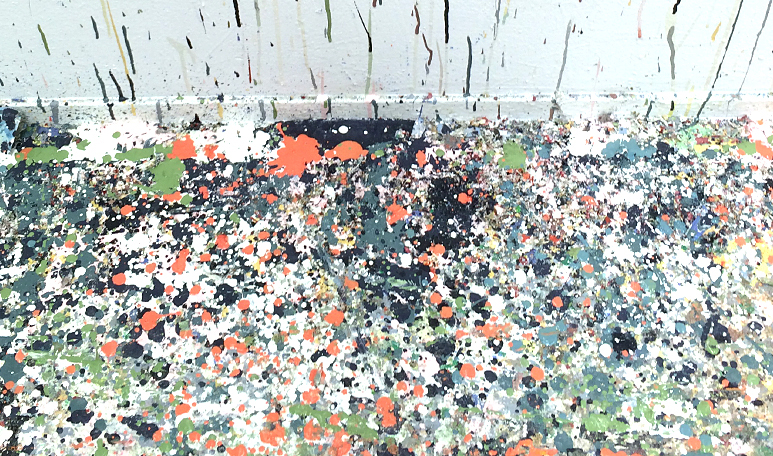 Yesterday I was painting and about 30 minutes in I got stuck. Sometimes when I don’t know what to do I try to think through the possibilities. I try to rationalize the next best move and work out in my mind why this possible decision would work or not.
Yesterday I was painting and about 30 minutes in I got stuck. Sometimes when I don’t know what to do I try to think through the possibilities. I try to rationalize the next best move and work out in my mind why this possible decision would work or not.
The conversation in my head goes something like this…
“If I paint this red circle in the middle right now it will make the painting look too much like a bulls eye. If I make it a square it will be too shapey, but if I paint it green then maybe it won’t notice too much but then I already have 3 other squares and do I want this painting to be about squares? If I do this might it possibly look a little too much like that artist’s work I saw last night that paints mostly squares? Is this why I am choosing squares? Well maybe I should paint a squiggly thing instead? But I never do squiggly things. That is not really me. Or is it? Maybe a small light colored one in the corner to try it out? But that seems kind of hesitant. Shouldn’t I be bold?”
Just from writing this tiny strand of dialogue I am instantly reminded of how it feels to be stuck and out of the creative flow. It is like trying to plan out how you are about to dance while trying to dance. It just doesn’t work too well. I know, of course, that this conversation goes on inside all of us whenever we problem solve. However, too much of it, for me, is actually exhausting. It is just not fun. I used to do it much longer than I do now.
The reason I limit the time I spend in this way of thinking is because it didn’t help me make my best work. My Art improved when the experience of making my Art improved. And that happened when I shifted more of my decision making from the rational to the intuitive.
Intuition is defined as “the ability to understand something immediately, without the need for conscious reasoning.”
Amazingly, once you let go of “conscious reasoning” there aren’t a whole lot of barriers standing in your way. Can I really just make a decision in a nano second according to a gut feeling and this actually will lead me somewhere different? More authentic? More easily? Really?
It seems too good to be true. No wonder Albert Einstein described intuition as “the most valuable thing” in life.
What is amazing to me is that I sometimes forget. I stop trusting this knowing. And when I do I tend to avoid the studio and instead choose something easier that doesn’t require me answering questions.
But what if you already knew all the answers? What if the more you answered the questions, the easier, the more joyful they became. What if these questions that only you have been ordained to answer were used to make Art that was so authentic, so like you that it allowed not only you, but everyone else to see the world in a brand new way?
Sometimes things that seem too good to be true actually are true.
How does intuition show up in your creative process? I would like to read some of your thoughts and comments on this.
In gratitude, Nicholas
THREE REASONS WHY MORE IS EASIER
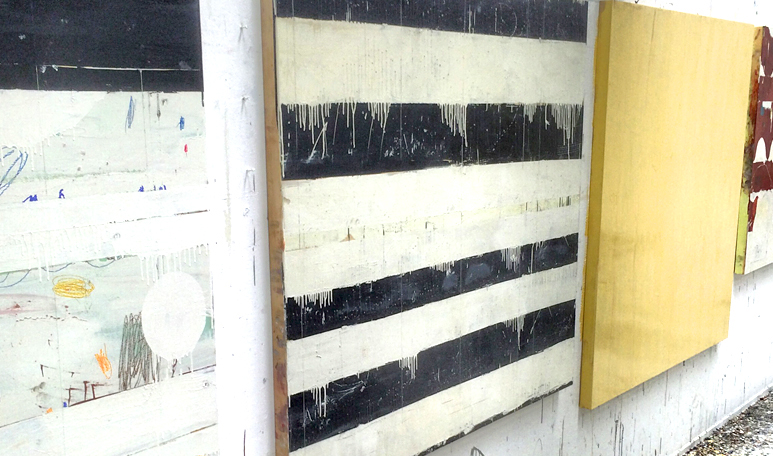 I am making a new series of paintings for a solo show in June. I have started 12 new paintings. I like to work on them all at the same time. Not so long ago I would have never tried to make so many all at once. I would at the most do 2 and even then I would try to finish the first before I started the second.
I am making a new series of paintings for a solo show in June. I have started 12 new paintings. I like to work on them all at the same time. Not so long ago I would have never tried to make so many all at once. I would at the most do 2 and even then I would try to finish the first before I started the second.
Process is incredibly important in making Art. I was never shown or given any particular information about process in art school and generally speaking artists don’t write or talk so much about how they make art. We just are left to figure this out on our own. I was interested in a process that was more efficient, but still allowed my work to easily change and develop. I also wanted to reduce the mental stress I used to go through in the pursuit of stronger work. I wanted it to be more fun.
Today, the process I use makes all these things possible. The big change happened when I shifted from working on single paintings to multiples. In other words I now work on 6 -12 paintings at the same time.
I rarely let one image get further ahead than the others. I develop a group of paintings now instead of just one. This simple shift in my process has made all the difference in the world. I have tripled my productivity, I am way less stressful as the work comes easier and – most importantly – I believe it results in stronger Art.
There seems to be 3 reasons why.
Repetition increases efficiency.
Starting something from nothing can be intimidating. Beginning is, for me, always a challenge. I tend to avoid this problem by checking my email, perusing things to eat in the fridge or even cleaning. In other words it can be just hard to begin…that is till you finally do, then you realize it actually is not that hard at all. It is more the thought or the idea of starting that is hard. So this breakthrough does always happen, and whether you are starting one painting or 6, it really doesn’t matter. You get into it and then once in the groove you can start on the remaining 5 at the same time. One procrastinating event to six paintings is way better than 6 procrastinating events to six paintings. It simply saves you endless time.
Newness avoids boredom
If I become bored in my practice it often means the work will too. This can lead to wasting time creating flat, uninspired work. Of course this does happen but I have found that if I can switch to a new painting at the very onset of tiredness or boredom, I can maintain a much higher energy level. So much is happening all at once on so many paintings in your studio that it becomes next to impossible to feel bored. Change is the antidote to boredom.
More happy accidents
Most of the time I do not entirely know where a body of work is headed before I begin. I usually start a new series that is somewhat like what I have made previously. I might have 12 paintings all starting out. I will work on all of them the same amount of time and generally I will like them all equally. But then, at some point, one of them will suddenly emerge as much, much stronger than the others. It might just be a corner of one or a single mark on another, but instantly I can recognize it as something different. Something new and potent.
Then I try to adjust the other 11 paintings to get them similarly strong. I allow this single unintentional, accidental occurrence to dictate the progress of the whole group. Then when this is almost completed another painting will shift and suddenly the bar is raised again. It feels like chance is making your work, but I believe this process invites and encourages much, much more of the artists subconscious, much more soul, into the process.
Everyone has a different process. Some things work for some and not others. Really what we are all after is a process that invites and encourages our authenticity and our individuality to emerge in our art. In a way, discovering your process is actually just part of the greater process of becoming an artist. Like our work, it shifts and changes too.
How has your process changed over time? I would love to read your comments below.
Curiously, Nicholas
THREE COLORS TO LAST YOUR LIFETIME
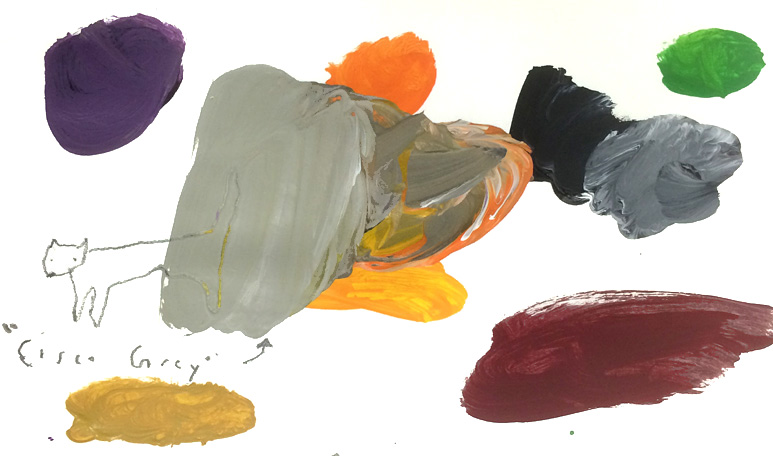 Do you notice how the same colors always show up in your work? I do. This is mostly because I love using certain ones. Color is personal. Everyone seems to have a few favorites. They stay unique to that person mostly because only they know the mix of colors that go into the making of them. Colors sometimes take years to develop. Some stay with you a long time, while others leave after only a short while. The really good ones, however, can last a lifetime.
Do you notice how the same colors always show up in your work? I do. This is mostly because I love using certain ones. Color is personal. Everyone seems to have a few favorites. They stay unique to that person mostly because only they know the mix of colors that go into the making of them. Colors sometimes take years to develop. Some stay with you a long time, while others leave after only a short while. The really good ones, however, can last a lifetime.
But only if they are really, really good.
Here then, are 3 of mine.
1 “Lyla’s White”
This color is named after my oldest daughter Lyla. I discovered it 10 years ago making a painting called “Lyla’s Dance.”
Titanium White
Yellow Ochre
Cadmium Yellow Light
The mix is mostly a very bright clean titanium white with just a smidge of yellow ochre thrown in…then ever so slowly, to brighten and cool this slightly ochrey white color you add just a very small smidgen of cadmium yellow light. You will see this paint all of a sudden just jump up. This white is gorgeous and reacts beautifully to other colors. It is not too sweet, or too drab or too white. It is just perfectly agreeable.
2 “Amazon Aqua”
Phthalo Green
Cadmium Yellow Light
Cerulean Blue
This is that green-blue color that reminds me of the shallows of tropical seas. It also shows up on certain tropical birds that live in the shade of rainforests. Certain butterflies carry this color upon their wings. Emeralds, tree frogs and iridescent insects share this color too.
It is not green nor blue nor yellow but miraculously straddles all three. It is made with Phthalo Green. This is one of those colors that often goes unused, but in order to make “Amazon Aqua”, Phthalo Green is essential. Again, Cadmium Yellow Light, in equal proportions, is used, with a smidgen of Cerulean blue. Give it a try. You will love it.
3 “Cisco’s Grey”
Titanium White
Carbon Black
Cadmium Orange
Yellow Ochre
Dioxine Purple
Cadmium Yellow Light
Cadmium Yellow Dark
Cadmium Red
Permanent Green Middle
Cisco was my cat. He died about 20 years ago but his color remains with me. This color is a warm, warm gray. It has the cozy warmth of a winter fire. It feels comforting like a hand knitted sweater.
When you make this color, it starts out super cold because you just use titanium white and carbon black to get to a medium value grey. Then you add in the other colors. It is totally visual of course. All these colors are in there but in small amounts. There is a lot of orange, however, in this grey and that is what makes it so lovely.
There is barely a place in my paintings that can’t be improved by the inclusion of this particular grey.
I hope you might find one or two of these as useful as I do.
What is your favorite color? How do you make it?
Please post below if you have a minute and tell us…super fun.
In gratitude, Nicholas
